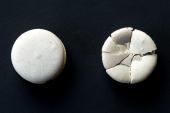Avoid Using Prasugrel With Cangrelor During PCI, SWAP-6 Affirms
The findings support current drug labeling, which says prasugrel should be given at the end of the cangrelor infusion.

Using prasugrel at the same time as cangrelor (Kengreal; Chiesi) during PCI creates an interaction that dampens antiplatelet effects and potentially leaves patients at risk for thrombotic complications, the randomized SWAP-6 study shows.
The antiplatelet effects of IV cangrelor are unaffected by concomitant use of prasugrel, but this strategy is associated with an increase in platelet reactivity at the end of the cangrelor infusion—by that point, there are low levels of the active metabolite of prasugrel remaining to bind to the previously occupied P2Y12 receptors.
This potentially dangerous drug-drug interaction is at least partly alleviated by administering prasugrel at the end of the cangrelor infusion, the currently recommended approach for switching between the two agents, according to researchers led by Francesco Franchi, MD (University of Florida College of Medicine – Jacksonville).
The findings are published online in JACC: Cardiovascular Interventions and are set to be presented by Mattia Galli, MD, PhD (University of Florida College of Medicine – Jacksonville and Maria Cecilia Hospital, Cotignola, Italy), at the upcoming European Society of Cardiology Congress 2023, which kicks off later this week in Amsterdam.
“Based on the ExcelsiorLOAD2 study, we thought there was not going to be a drug-drug interaction, and we were wrong,” senior author Dominick Angiolillo, MD, PhD (University of Florida College of Medicine – Jacksonville), told TCTMD. “The study findings clearly show that when you are administering prasugrel together with cangrelor, by the end of the cangrelor infusion, there is essentially a very limited residual effect from prasugrel, with an increase in platelet activity, which strongly supports the presence of a drug-drug interaction.”
He said that supports recommendations on current US Food and Drug Administration and European Medicines Agency labels for how prasugrel should be administered after IV cangrelor—at the end of the infusion—"but also suggests that this clearly should not be done in clinical practice because there’s a risk for harm.”
The SWAP-6 Study
Prasugrel, a thienopyridine, has seen growing use since it became generic, but there are very limited data on using the drug when transitioning from cangrelor, Angiolillo said. Although some research has been conducted in this context, there has not been a single study specifically designed to explore the possibility of a drug-drug interaction in patients undergoing PCI. Prior studies have shown that there is an interaction that lessens platelet inhibition when clopidogrel, another thienopyridine, is used concomitantly with IV cangrelor.
SWAP-6 was an open-label pharmacokinetic and pharmacodynamic study that included 77 high-risk patients (mean age roughly 63 years; 22% women) who were undergoing PCI for stable CAD or NSTE ACS. They were randomized to three treatment groups:
- Prasugrel alone at the start of PCI
- Cangrelor and prasugrel together at the start of PCI
- Cangrelor at the start of PCI followed by prasugrel at the end of the infusion
Prasugrel was given as a 60-mg loading dose followed, 24 hours later, by a 10-mg daily maintenance dose. Cangrelor was administered as a 30-µg/kg bolus followed by a 4-µg/kg/min infusion lasting for 2 hours or until the end of PCI (whichever was longer).
Compared with prasugrel alone, cangrelor provided enhanced platelet inhibition, although among patients treated with both drugs concomitantly, there was an increase in platelet reactivity after the end of the infusion. By 3 hours after the prasugrel and cangrelor loading doses, in fact, VerifyNow P2Y12 reaction unit (PRU) levels were significantly higher among patients treated with both drugs concomitantly than among those treated with prasugrel alone.
We thought there was not going to be a drug-drug interaction, and we were wrong. Dominick Angiolillo
The primary endpoint was a comparison of PRU levels at 4 hours after randomization between patients receiving prasugrel and cangrelor together and those receiving prasugrel alone, and at this time point, platelet inhibition was greater in those treated with prasugrel alone. PRU levels were lower, with a least-square means difference of 130 (95% CI 85-176), failing to show that concomitant use of the two drugs was noninferior to prasugrel alone.
This difference in platelet inhibition was less pronounced in the third arm of the trial: patients who received prasugrel after the end of the cangrelor infusion. PRU levels were significantly higher in this group than in the patients treated with prasugrel alone but significantly lower than in the patients treated with the two drugs concomitantly.
Pharmacodynamic studies bolstered these results, showing that plasma levels of prasugrel’s active metabolite available to bind with the P2Y12 receptors were low after the end of the cangrelor infusion in patients who received both drugs together. Moreover, metabolite levels at 1 and 2 hours after the cangrelor infusion were lower among patients who had received both drugs concomitantly than among those who received prasugrel after the end of the infusion.
Support for Current Recommendations
SWAP-6 was not designed to assess impacts on clinical events, and there were no ischemic or major bleeding events observed during the study. “But the pharmacodynamic data are so compelling that the strategy of administering the two drugs concomitantly should be avoided and one should follow the FDA label,” Angiolillo said.
Even though these results are consistent with current drug labels, there is a lot of confusion out in practice when it comes to transitioning from cangrelor to oral P2Y12 inhibitors. Studies have shown that it’s safe to use ticagrelor at the same time as cangrelor but that prasugrel and clopidogrel, which have shorter half-lives than ticagrelor, should be started only at the end of the cangrelor infusion to ensure that there is enough drug circulating when the P2Y12 receptors are vacated by cangrelor.
These new findings can be used to guide how these agents are used in practice, Angiolillo said, and they are strong enough to support updated drug labels, which currently contain recommendations based on limited data.
“It would have been nice to show that you can give the drug in the cath lab so you don’t have to think about giving the oral drug at the end of the cangrelor infusion, because it’s just more practical to give it when the patient’s on the cath lab table, but that’s not the case,” he said. “We should not be doing it.”
Todd Neale is the Associate News Editor for TCTMD and a Senior Medical Journalist. He got his start in journalism at …
Read Full BioSources
Franchi F, Rollini F, Ortega-Paz L, et al. Switching from cangrelor to prasugrel in patients undergoing percutaneous coronary intervention: the Switching Antiplatelet-6 (SWAP-6) study. J Am Coll Cardiol Intv. 2023;Epub ahead of print.
Disclosures
- The study was funded by an investigator-initiated grant from the Scott R. MacKenzie Foundation.
- Franchi reports having received personal consulting fees or honoraria from AstraZeneca, Bayer, and Sanofi and institutional payments for grants from PLx Pharma and the Scott R. MacKenzie Foundation.
- Angiolillo reports having received consulting fees or honoraria from Abbott, Amgen, AstraZeneca, Bayer, Biosensors, Boehringer Ingelheim, Bristol Myers Squibb, Chiesi, CSL Behring, Daiichi Sankyo, Eli Lilly, Haemonetics, Janssen, Merck, Novartis, PhaseBio, PLx Pharma, Pfizer, Sanofi, and Vectura, as well as research grants to his institution from Amgen, AstraZeneca, Bayer, Biosensors, CeloNova, CSL Behring, Daiichi Sankyo, Eisai, Eli Lilly, Gilead, Idorsia, Janssen, Matsutani Chemical Industry Co., Merck, Novartis, and the Scott R. MacKenzie Foundation.
- Galli reports no relevant conflicts of interest.





Comments